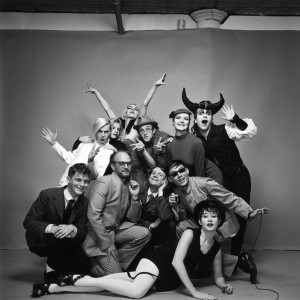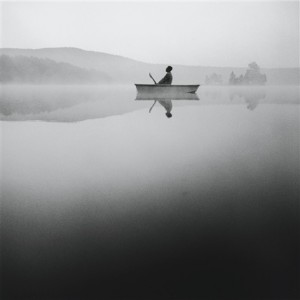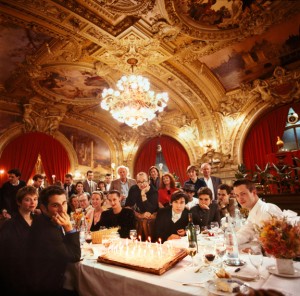New York, New York, 1979. Photograph by Tseng Kwong Chi. Courtesy of Muna Tseng Dance Projects, Inc.
It’s not often that an exhibition, not to mention one by an artist whose name I have never heard before, makes me feel like a kid in a candy shop. I did not expect my visit to the Tseng Kwong Chi retrospective Tseng Kwong Chi: Performing for the Camera to be one of those instances, yet I left the Block Museum with a new artist to list as a photographic hero and a few new prints to add to my list of artwork to collect after I earn my first million.
Walking into the exhibition, it’s immediately clear why Tseng had such an impressive group of friends, from Keith Haring to Madonna to Jean-Michel Basquiat. The same charm the artist used to score pictures with Henry Kissinger and Yves Saint Laurent when he was still an unknown (and uninvited) photographer comes across in every piece of work he put forth – if not at first glance in the strictly postured East Meets West self-portrait series, then at least at closer inspection of the ID badge hanging from his vintage Chinese communist worker’s suit, which reads “SLUTFORART” in tiny font.
Tseng seems his most natural, bubbly self in the polaroid boards he compiled using a makeshift photo booth he would set up at club entrances. In the photos, he interacts with the partygoers, smiling alongside them or playing along with their improvised jumps and poses – always wearing his Mao suit and ID badge. That playful side of Tseng is also present in the group portraits he staged, which constitute many a who’s who of the New York art scene in the early 1980s and seem to capture a group of exuberantly happy individuals who loved one another’s company. Tseng captured these figures in their purist forms, often while in costumes of some sort, revealing more truth about their subjects than words ever could.
Art After Midnight, New York. Photograph by Tseng Kwong Chi. Courtesy of Muna Tseng Dance Projects, Inc.
In East Meets West, Tseng shifts his focus from a candid version of himself to a much more composed one. In the photos, he stands before western tourist attractions like the Eiffel Tower and the Empire State Building, always clutching the shutter release cable for his Rolleiflex in one hand. Tseng described himself as the “ambiguous ambassador” of his time – straddling the East and the West, he was born in China but spent many formative years in Montreal and Paris before moving to in New York. In his Mao suit, it would be fair to assume at first glance that Tseng hopes to represent China, drawing a direct comparison between his eastern roots and the western landmarks that stand tall behind him; however, as you get to know Tseng through his work, you begin to understand that his identity was much more complex, blending East and West to create a persona that was uniquely his own.
Never has an artist struck me as so genuine when creating a self-portrait. Tseng’s technique shows intention, not arrogance, with such a sure knowledge of kind of art he wanted to make, what he wanted it to say, and why he himself needed to be in the frame to make that happen. A rare series that doesn’t feature Tseng, Moral Majority, gives viewers insight into the political views that his work espoused. According to this series’ description, “Tseng employs performance, irony, and identity politics to criticize the conservative values held by this fundamental Christian group and their Republican allies, whom Tseng felt espoused anti-immigrant, anti-gay, anti-feminist, and anti-abortion views.”
In one such portrait, Tseng himself stands beside one of the party’s members, smiling in a seersucker suit to “confront the group’s emphasis on racial and class ‘purity.’” By shedding his overly dignified, straight-face, Mao-donning persona and flashing a wide smile, Tseng allows his identity and the irony of the situation itself to do the talking. He needn’t try too hard to make his subjects look as ridiculous as he saw them to be; just his presence with them as a gay Chinese immigrant in front of that crumpled flag could do the trick.
Lake Ninevah, Vermont. Photograph by Tseng Kwong Chi. Courtesy of Muna Tseng Dance Projects, Inc.
Equal to the star power of the artist himself is his masterful understanding of composition. As The Twin Towers rise up behind him in one East Meets West portrait, his figure fits perfectly before one tower, parallel to its façade and catching the light for an exquisite contrast. The above photo he staged of himself rowing across Lake Ninevah in Vermont is so aesthetically appealing in form that the one photo could be the subject on a class about how to beautifully photograph both portraits and landscapes.
But the true gem of this show is Keith Haring’s Birthday Party, Le Train Bleu, Paris. I don’t know how to objectively describe a photo that has so wholly captured my heart (hence why it is pictured below). Tseng booked this ballroom for Haring’s party and set up this photo to document the occasion, again creating such a perfect composition that any technical description of it completely escapes me. Keith and his guests stare lovingly at the camera and thus its operator; the photo’s vibrancy and Tseng’s absence from it strike me as a symbol of Tseng’s tragic 1990 death of AIDS and the hole it left in modern art history. That may sound like a leap, but for an artist who created such powerful and often joyful art, it seems only fair that his contemporaries would see him off with as ornate, vivid, and warm a scene as this one.
Keith Haring’s Birthday Party, Le Train Bleu, Paris. Photograph by Tseng Kwong Chi. Courtesy of Muna Tseng Dance Projects, Inc.




608 Comments
https://jatihusada.id/plugins/wp-ajax/?okegas=ebony88%20slot
EBONY88 👑 Situs Para Pecinta Slot Modal Kecil Untung Besar Pasti Maxwin
https://alammedica.id/plugins/wp-ajax/?okegas=ebony88%20slot%20login
EBONY88 👑 Situs Para Pecinta Slot Modal Kecil Untung Besar Pasti Maxwin